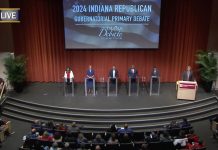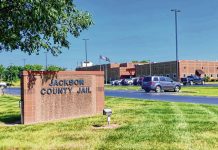A statewide conference focusing on preserving historic places has chosen Columbus to host this year’s event.
Indiana Landmarks, in partnership with Indiana University and the Indiana Division of Historic Preservation and Archaeology, will present “Preserving Historic Places,” its 49th annual conference, April 17 to 20 with conference sessions at First Christian Church and other downtown locations.
About 200 people are expected to register for the event.
“We’ve never been to Columbus,” said Suzanne Stanis, director of Heritage Education for Indiana Landmarks. “Our planning committee was shocked that we had not. It’s been overlooked — but not intentionally.”
[sc:text-divider text-divider-title=”Story continues below gallery” ]
The committee that selects the site chose Columbus for its renowned and well-known examples of Modern architecture, and particularly because some of the city’s most revered buildings are turning 50, Stanis said.
“And the city has wonderful examples of 19th and 20th century architecture as well,” she said.
The Columbus Visitors Center board agreed to a sponsorship for the conference, contributing $10,000 to bring the event to Columbus, said Karen Niverson, Visitors Center executive director.
The board concluded that bringing a historical preservation conference to Columbus was a perfect match to the city’s efforts to preserve its architectural treasures.
Columbus earned the moniker “Athens of the Prairie” in the 1960s for its world-class architecture and enlightened leadership. In 2012, Columbus was ranked the nation’s sixth most architecturally important city in the nation by the American Institute of Architects.
First Christian Church, 531 Fifth St., a National Historic Landmark built in 1942 and designed by Eliel and Eero Saarinen, will serve as the conference headquarters.
Cleo Rogers Memorial Library — the Bartholomew County Public Library’s flagship, designed by I.M. Pei in 1969 — will host other sessions at 536 Fifth St. Two meals take place at The Commons, 300 Washington St., adapted from Cesar Pelli’s design, with the kinetic sculpture Chaos I by Jean Tinguely. A buffet dinner will be conducted in the historic barn at the Henry Breeding Farm near Edinburgh.
Sessions will focus on how to increase effectiveness of local preservation commissions, the nuts and bolts of historic preservation, using easements as a preservation tool and the economic impact of preservation efforts.
Several of the sessions revolve around Columbus’ unique architectural treasures, including a session at the Upland Columbus Pump House, 148 Lindsey St., to talk about creative adaptive uses. The session will focus on the renovation of the 1903 Pump House designed by Harrison Albright, who also was the architect for the West Baden Springs Hotel, while participants sample Upland’s craft beers.
Another on-site session is called “Refreshing the Recent Past: Renovation of the Cummins Corporate Office Building,” where participants will talk with Cummins officials about how they plan to update the building while respecting the original design in 1983 by Irish-born, American Pritzker Prize-winning architect Kevin Roche.
Keynote speaker Donovan Rypkema of PlaceEconomics in Washington, D.C., will outline his firm’s findings in a just-completed study of the economic and quality-of-life impact of preservation in Indianapolis.
Also among the sessions being offered is “The Columbus Way,” presented by Jack Hess, executive director of CivicLab. The session is about how each community has a distinct personality based on its history, institutions and generational leadership. “The Columbus Way” was how a Harvard Business school case study described the city’s ability to think about the future while respecting the past.
Richard McCoy, director of Landmark Columbus, an organization dedicated to preserving and maintaining Columbus’ architectural heritage, will present “Appreciation Starts at Home: Building Community Pride.” Co-presenter is Tyrell Anderson from the Gary Decay Devils organization.
McCoy said he plans to talk about the cultural and social value that programs such as Exhibit Columbus can bring to a community, igniting a passion for historic preservation among those who might not know about this part of the city’s cultural heritage.
“Exhibit Columbus is, in a way, a preservation project,” he said. “We are growing a community that cares about the design heritage of Columbus and wants to see it go forward.”
Exhibit Columbus included 18 site-responsive installations that connected with and commented on Columbus’ design legacy, with the installations in place from August through November. The bi-annual exhibition generated national and international attention for Columbus.
“We didn’t renovate a building or fix a roof as an act of preservation (as part of Exhibit Columbus), but we had third-graders interested in old buildings,” McCoy said. “We had high school students designing an exhibit. I’m really excited about that.”
Having Columbus host the Indiana Landmarks conference is a recognition of all the work that has been going on for the past decade in historic preservation in Columbus, McCoy said.
The notable historic renovation has included Zaharakos, the 1900 era ice cream shop renovated from 2007-09 by Tony Moravec, who later bought the Columbus Pump House and in 2015-16 renovated it into the Upland Brewery location.
Cummins began renovating the former Irwin National Bank location in 2012 and became one of 11 buildings honored during the 2015 Modernism in America Awards, where it received a citation of merit.
In the citation, the awards jury commended the 14 companies that participated in the building’s $5.25 million renovation for “showing great care” while intervening in the original designs, as well as completing a “well-articulated and executed project.”
McCoy said the city is becoming well known for its preservation efforts.
“Columbus has been doing a lot of stuff right,” McCoy said.
The Preserving Historic Places Conference is known as a traditional historical preservation conference focusing on late 19th century and early 20th century buildings, so it isn’t surprising that the committee would now look toward Columbus, McCoy said.
“The shift is, Modern Heritage is now old,” McCoy said. “First Christian Church is 75 years old,” he said. “The Bartholomew County Library will be 50 years old in 2019. Lincoln Elementary is 50 years old. Columbus has always been known for what’s new, but now we’re ‘old Modern Heritage.’ “
Although Columbus no longer has the conference space that had been offered at The Clarion Hotel & Conference Center, as demolition is underway there, Niverson said the conference attendees prefer having their headquarters and sessions in historically significant buildings.
“We are so thankful to have such great community partners who are opening the doors of their historic structures for this,” Niverson said.
Registrants can sign up for a conference tour of the J. Irwin and Xenia Miller House. The National Historic Landmark, designed by Eero Saarinen in 1953, features original interiors by Alexander Girard and a landscape by the renowned Dan Kiley.
Tours will also offered of the Cummins Corporate Office Building and the Irwin Conference Center. And conference-goers can also take advantage of the Columbus Area Visitors Center’s self-guided smartphone tours and downtown walking tours.
[sc:pullout-title pullout-title=”About the conference” ][sc:pullout-text-begin]
What: Preserving Historic Places conference
When: April 17-20
Where: Conference headquarters will be First Christian Church, 531 Fifth St., Columbus.
How to register: Earlybird registration by March 2 is $150, with student registration at $75. The cost doubles after that deadline. The conference is open to the public.
For more information: Indiana Landmarks may be reached at 317-639-4534.
[sc:pullout-text-end]




